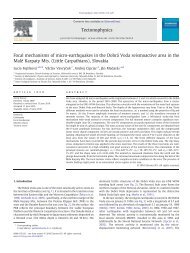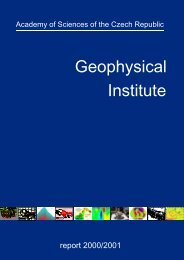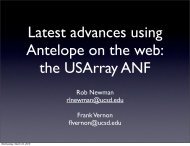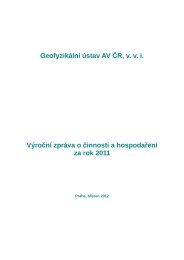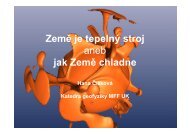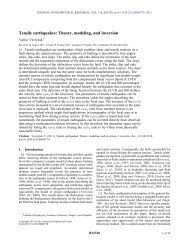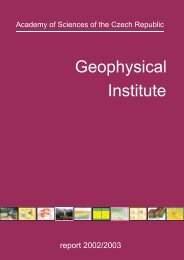Geophysical Institute of the ASCR
Geophysical Institute of the ASCR
Geophysical Institute of the ASCR
You also want an ePaper? Increase the reach of your titles
YUMPU automatically turns print PDFs into web optimized ePapers that Google loves.
was designed to continue previous experiments Polonaise’97 and CELEBRATION 2000 (Guterch et<br />
al. 1999, 2003) and it was prepared in <strong>the</strong> same geometry. Scientific organizations involved were led<br />
by <strong>the</strong> experiment teams from geophysical and geological communities in <strong>the</strong> Czech Republic,<br />
Poland, Austria, <strong>the</strong> USA, Canada, <strong>the</strong> Slovak Republic, Hungary, Denmark and Finland. In <strong>the</strong> Czech<br />
Republic, experts from <strong>the</strong> <strong>Geophysical</strong> <strong>Institute</strong> <strong>of</strong> <strong>the</strong> <strong>ASCR</strong>, <strong>Institute</strong> <strong>of</strong> Rock Structure and<br />
Mechanics <strong>of</strong> <strong>the</strong> <strong>ASCR</strong>, and <strong>Institute</strong> <strong>of</strong> <strong>the</strong> Physics <strong>of</strong> <strong>the</strong> Earth MUNI Brno participated in <strong>the</strong><br />
project.<br />
The layout <strong>of</strong> each experiment was a network <strong>of</strong> interlocking recording pr<strong>of</strong>iles (Fig. 17). Shots were<br />
fired along each pr<strong>of</strong>ile with <strong>the</strong> average distance <strong>of</strong> 30 km, data were sampled at intervals <strong>of</strong> 10 ms<br />
and were recorded mainly by one-component stations TEXANs with station spacing 3 km. For more<br />
details about SLICE project refer to Brož et al. 2005.<br />
Interpretation <strong>of</strong> a large set <strong>of</strong> refraction and wide-angle reflection data involved three different<br />
approaches: (i) tomographic inversion <strong>of</strong> <strong>the</strong> first arrivals <strong>of</strong> P waves; (ii) parametric kinematic<br />
inversion <strong>of</strong> travel times <strong>of</strong> Pg, Pn and PmP waves; (iii) trial-and-error forward modelling <strong>of</strong> <strong>the</strong> entire<br />
wave field with SEIS83 program package (Hrubcová et al., 2005). The results <strong>of</strong> <strong>the</strong>se three methods<br />
gave 2-D velocity models down to <strong>the</strong> depth <strong>of</strong> 40-50 km with P-wave velocities ranging around<br />
3.5 km/s in sedimetary basins to 8.5 km/s for <strong>the</strong> uppermost mantle parts (Fig. 18). Relative velocity<br />
errors were in range <strong>of</strong> 5% depending on ray coverage, <strong>the</strong> uncertainties in <strong>the</strong> Moho depth<br />
determinations were less than ± 2.5 km. The differentiation <strong>of</strong> <strong>the</strong> wave field, velocity models and <strong>the</strong><br />
depth <strong>of</strong> Moho in different areas enabled to determine three types <strong>of</strong> crust-mantle transition in <strong>the</strong><br />
Bohemian Massif reflecting variable crustal thickness and delimiting contacts <strong>of</strong> tectonic units in<br />
depth. These models are consistent with hypo<strong>the</strong>sis <strong>of</strong> laminated Moho, sharp or gradual velocity<br />
transition at Moho depth or indications <strong>of</strong> low velocity anomalies in lower crust.<br />
Fig. 18. Comparison <strong>of</strong> two depth-velocity cross-sections.<br />
35




